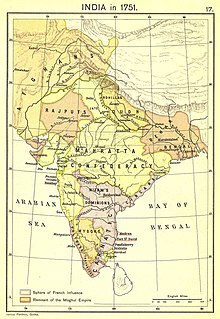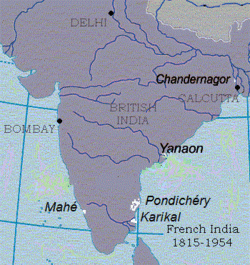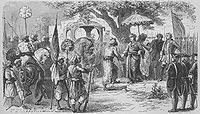|
French India
French India, formally the Établissements français dans l'Inde[a] (English: French Settlements in India), was a French colony comprising five geographically separated enclaves on the Indian subcontinent that had initially been factories of the French East India Company. They were de facto incorporated into the Republic of India in 1950 and 1954. The enclaves were Pondichéry, Karikal, Yanam on the Coromandel Coast, Mahé on the Malabar Coast and Chandernagor in Bengal. The French also possessed several loges ('lodges', tiny subsidiary trading stations) inside other towns, but after 1816, the British denied all French claims to these, which were not reoccupied. By 1950, the total area measured 510 km2 (200 sq mi), of which 293 km2 (113 sq mi) belonged to the territory of Pondichéry. In 1936, the population of the colony totalled 298,851 inhabitants, of which 63% (187,870) lived in the territory of Pondichéry.[4] Background       France was the last of the major European maritime powers of the 17th century to enter the East India trade. Six decades after the foundation of the English and Dutch East India companies (in 1600 and 1602 respectively), and at a time when both companies were multiplying factories (trading posts) on the shores of India, the French still did not have a viable trading company or a single permanent establishment in the East. Seeking to explain France's late entrance in the East India trade, historians cite geopolitical circumstances such as the inland position of the French capital, France's numerous internal customs barriers, and parochial perspectives of merchants on France's Atlantic coast, who had little appetite for the large-scale investment required to develop a viable trading enterprise with the distant East Indies.[5][6] HistoryInitial marine voyages to India (16th century)The first French commercial venture to India is believed to have taken place in the first half of the 16th century, in the reign of King Francis I, when two ships were fitted out by some merchants of Rouen to trade in eastern seas; they sailed from Le Havre and were never heard of again. In 1604, a company was granted letters patent by King Henry IV, but the project failed. Fresh letters patent were issued in 1615, and two ships went to India, only one returning.[7] La Compagnie française des Indes orientales (French East India Company) was formed under the auspices of Cardinal Richelieu (1642) and reconstructed under Jean-Baptiste Colbert (1664) when he sent an expedition to Madagascar.[8][9][7] First factory in India (1668)In 1667, the French India Company sent out another expedition, under the command of François Caron (who was accompanied by a Persian named Marcara), which reached Surat in 1668 and established the first French factory in India.[8][9] French expansion in India (1669-1672)In 1669, Marcara succeeded in establishing another French factory at Masulipatam. In 1672, the French captured Fort Saint Thomas, but they were driven out by the Dutch after a long and costly siege. Chandernagore (present-day Chandannagar) was established in 1692, with the permission of Nawab Shaista Khan, the Mughal governor of Bengal. In 1673, the French acquired the area of Pondicherry from the qiladar of Valikondapuram under the Sultan of Bijapur, and thus the foundation of Pondichéry was laid. By 1720, the French had lost their factories at Surat, Masulipatam and Bantam to the British East India Company. Establishment of colony at Pondichéry (1673)On 4 February 1673, Bellanger de l'Espinay, a French officer, took up residence in the Danish Lodge in Pondichéry, thereby commencing the French administration of Pondichéry. In 1674, François Martin, the first Governor, initiated ambitious projects to transform Pondichéry from a small fishing village into a flourishing port-town. However, the French found themselves in continual conflict with the Dutch and the English. In 1693, the Dutch captured Pondichéry and augmented the fortifications. The French regained the town in 1699 through the Treaty of Ryswick, signed on 20 September 1697. Establishment of colonies at Yanon (1723) and Karaikal (1739)From their arrival until 1741, the objectives of the French, like those of the British, were purely commercial. During this period, the French East India Company peacefully acquired Yanam (about 840 kilometres or 520 miles north-east of Pondichéry on Andhra Coast) in 1723, Mahe on Malabar Coast in 1725 and Karaikal (about 150 kilometres or 93 miles south of Pondichéry) in 1739. In the early 18th century, the town of Pondichéry was laid out on a grid pattern and grew considerably. Able governors like Pierre Christophe Le Noir (1726–1735) and Pierre Benoît Dumas (1735–1741) expanded the Pondichéry area and made it a large and rich town. Ambition of establishment of French territorial empire in India and defeat (1741–1754)Soon after his arrival in 1741, the most famous governor of French India, Joseph François Dupleix, began to hold the ambition of a French territorial empire in India in spite of the pronounced uninterested attitude of his distant superiors and of the French government, which didn't want to provoke the British. Dupleix's ambition clashed with British interests in India and a period of military skirmishes and political intrigues began and continued even in rare periods when France and Great Britain were officially at peace. Under the command of the Marquis de Bussy-Castelnau, Dupleix's army successfully controlled the area between Hyderabad and Cape Comorin. However, Robert Clive, a British officer, arrived in India in 1744, and dashed the hopes of Dupleix to create a French empire in India. After a defeat and failed peace talks, Dupleix was summarily dismissed and recalled to France in 1754. French vs British intrigues (1754–1871)In spite of a treaty between the British and French agreeing not to interfere in regional Indian affairs, their colonial intrigues continued. The French expanded their influence at the court of the Nawab of Bengal and increased their trading activity in Bengal. In 1756, the French encouraged the Nawab (Siraj ud-Daulah) to attack and take the British Fort William in Calcutta. This led to the Battle of Plassey in 1757, where the British decisively defeated the Nawab and his French allies, resulting in the extension of British power over the entire province of Bengal. Subsequently, France sent Lally-Tollendal to recover the lost French possessions and drive the British out of India. Lally arrived in Pondichéry in 1758, had some initial success and razed Fort St. David in Cuddalore District to the ground in 1758, but strategic mistakes by Lally led to the loss of the Hyderabad region, the Battle of Wandiwash and the siege of Pondicherry in 1760. In 1761, the British razed Pondichéry to the ground in revenge for the French depredations; it lay in ruins for four years. The French had lost their hold now in South India too. In 1765, Pondichéry was returned to France in accordance with a 1763 peace treaty with Britain. Governor Jean Law de Lauriston set to rebuild the town on its former layout and after five months 200 European and 2000 Tamil houses had been erected. In 1769, the French East India Company, unable to support itself financially, was abolished by the French Crown, which assumed administration of the French possessions in India. During the next 50 years, Pondichéry changed hands between France and Britain with the regularity of their wars and peace treaties. In 1816, after the conclusion of the Napoleonic Wars, the five establishments of Pondichéry, Chandernagore, Karaikal, Mahe and Yanam and the lodges at Machilipatnam, Kozhikode and Surat were returned to France. Pondichéry had lost much of its former glory, and Chandernagore dwindled into an insignificant outpost to the north of the rapidly growing British metropolis of Calcutta. Successive governors tried, with mixed results, to improve infrastructure, industry, law and education over the next 138 years. By a decree of 25 January 1871, French India was to have an elective general council (conseil général) and elective local councils (conseil local). The results of this measure were not very satisfactory, and the qualifications for and the classes of the franchise were modified. The governor resided at Pondichéry and was assisted by a council. There were two Tribunaux d'instance (Tribunals of first instance) (at Pondichéry and Karikal) one Cour d'appel (Court of Appeal) (at Pondichéry) and five Juges de paix (Justices of the Peace). Agricultural production consisted of rice, peanuts, tobacco, betel nuts and vegetables.[7]  Independence movement (18th–20th century) and merger with India (1954)The Independence of India on 15 August 1947 gave impetus to the union of France's Indian possessions with former British India. The lodges in Machilipatnam, Kozhikode and Surat were ceded to India on 6 October 1947.[10] An agreement between France and India in 1948 agreed to an election in France's remaining Indian possessions to choose their political future. Governance of Chandernagore was ceded to India on 2 May 1950; it was then merged with West Bengal state on 2 October 1954. On 1 November 1954, the four enclaves of Pondichéry, Yanam, Mahe– and Karikal were de facto transferred to the Indian Union and became the Union Territory of Puducherry. The de jure union of French India with India did not take place until 1962 when the French Parliament in Paris ratified the treaty with India. The myth of "our immense empire in India"From the mid-19th century onward there developed in France the belief that the five tiny settlements recovered from Britain after the Napoleonic Wars were remnants of the "immense empire" acquired by Dupleix in the 18th century. "Our immense empire of India was reduced to five settlements" wrote French economist and colonial expansion promoter Pierre Paul Leroy-Beaulieu in 1886.[11] An atlas published in the 1930s described those five settlements as "remnants of the great colonial empire that France had created in India in the 18th century".[12] More recently, a historian of French India post-1816 described them as "debris of an empire" and the "last remnants of an immense empire forever lost".[13] However, France never held much more than the five settlements recovered in 1816. The historian of French India and archivist Alfred Martineau, who was also governor of French India, pointed out that the authority granted to Dupleix over the Carnatic in 1750 should not be construed as a transfer of sovereignty, as wrote most historians, given that Dupleix only became so to speak the lieutenant of the Indian subah, who could withdraw his power delegation at his convenience.[14] Philippe Haudrère, historian of the French East India Company, also wrote that Dupleix controlled those territories through a complex system of treaties and alliances, a system almost feudal in nature, territories guarded by garrisons with French commanders, but neither annexed nor transformed into protectorates.[15] List of French settlements in IndiaFrench establishments in the Indian peninsula as of 1839 were:[16]
Under the French East India Company's regime, the name 'lodge' was given to factories or insulated establishments consisting of a home and adjacent ground where France had the right to fly its flag and establish trading posts.
List of chief governing officersCommissioners
GovernorsIn the days of the French East India Company, the title of the top official was most of the time Governor of Pondicherry and General Commander of the French settlements in the East Indies (French: Gouverneur de Pondichéry et commandant général des établissements français aux Indes orientales). After 1816, it was Governor of French establishments in India (French: Gouverneur des établissements français de l'Inde').  
French India became an Overseas territory (French: territoire d'outre-mer) of France in 1946. Commissioners
French India de facto transferred to the Republic of India in 1954. High CommissionersThe first High Commissioner, Kewal Singh was appointed immediately after the Kizhoor referendum on 21 October 1954 as per Foreign Jurisdiction Act, 1947.[19]: 964 The Chief Commissioner had the powers of the former French commissioner, but was under the direct control of the Union Government.[20]: 198 The list of Chief Commissioners is given below[19]: 977
See also
Notes
References
Bibliography
External linksWikimedia Commons has media related to French India. |
||||||||||||||||||||||||||||||||||||||||||||||||||||||||||||||||||||||||||||||||||||||||||||||||||||||||||||||||||||||||










